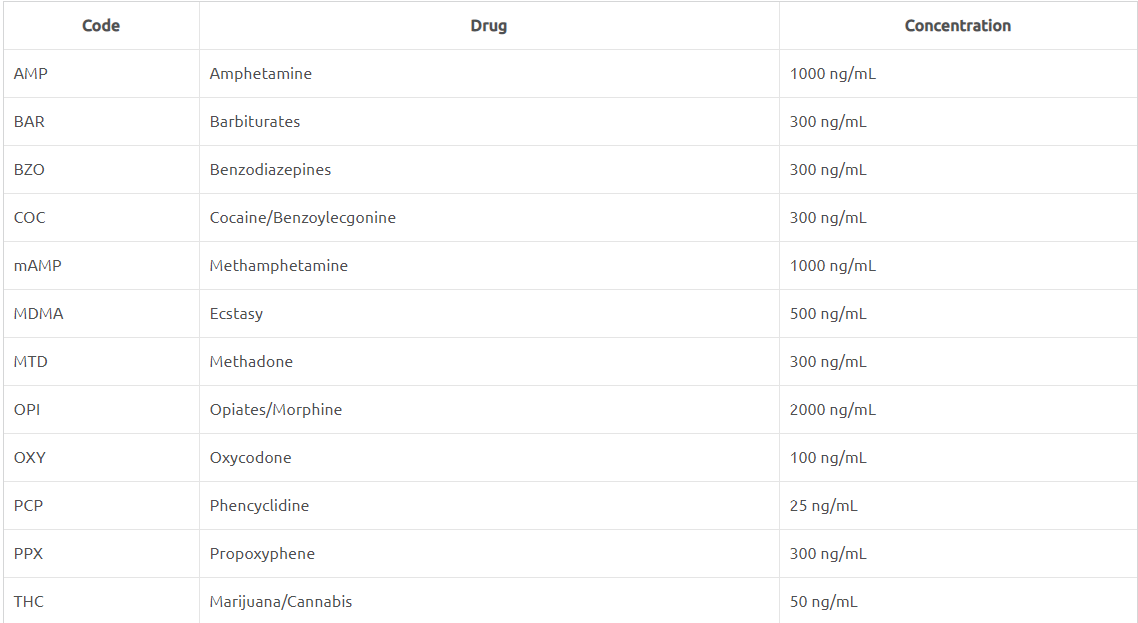All You Need To Know About Drug Testing

All You Need to Know About Drug Testing
Drug addiction is a global problem. Despite all the efforts that the government is making to prevent further damage, several drug manufacturers and distributors continue to find ways to continue with their illegal business. This is why drug testing has evolved as a precautionary measure to minimize the impact of substance abuse.
History of Drug Testing in America
Drug testing is the backbone of the drug court system in the United States:
Drug Testing in the 60's
The U.S. Department of Defense (DOD) began large-scale random drug testing during the late 1960s to bust military personnel deployed in Vietnam for marijuana and heroin use. The DOD’s efforts to catch drug abusers in its Asian operation led directly to developments in urine drug testing technology, including establishing cutoff levels for drug traces in the body. Any traces of drugs found to be above these established levels would be seen as a positive reading while anything below them would not be detected and would, therefore, render the test as negative.
In the following years, workplace screening in the form of random drug testing and post-accident drug testing became more commonplace, especially after President Ronald Reagan’s 1986 directive on drug abuse and drug-free workplaces.
In the early 1980s, the criminal justice system, the Federal Bureau of Investigation and many other Federal, State and local agencies started incorporating drug testing into their investigations and operations.
Drug Testing in the Courts
Unlike military drug testing, drug testing in the criminal justice system has not seen the establishment of consistent cutoff levels that are uniformly enforced. This is because the range of applications of drug testing programs in the criminal justice environment required the development of policies and protocols exclusive to the criminal justice system.
While random drug testing in the military or workplace is aimed at ridding the organization of drug abusers, court-ordered random drug testing within the is done for a variety of reasons:
- Prosecution
- Supervision of a defendant’s compliance with a pretrial release or probation
- Monitoring a participant’s treatment progress and compliance with drug court program conditions.
For drug courts, random drug testing is done mostly to monitor a defendant’s treatment progress to determine if that person has been doing drugs, and if so what type and how much. The test results can be used for ordering further treatment service or even reducing treatment service requirements if the results show that the person is, in fact, reducing their drug intake (even if they haven’t quit completely).
Drug Testing FAQs
Is a faint line on a drug test still negative?
Despite the words “positive” and “negative” being used in a very black-and-white manner, the drug tests are anything but black-and-white. For the purposes of a drug court program, these tests determine the presence or absence of drug metabolites in a given sample either above or below established cutoff limits. How the laboratory interprets and the court responds to these results depends on:
- the biological process that affects the length of time different drugs stay in the human body;
- interactions of one drug with another;
- distribution and elimination rates of the drugs in question;
- the participant’s drug history and other physical characteristics;
- how effectively the tests can identify potential cheating (e.g., flushing or water loading) that may affect the test results;
- the effect of other variables, such as the individual’s health, physical condition, and duration of drug use, on the test analysis.
What are the different types of drug tests?
Organizations of all kinds can choose to issue a urine test, oral fluid test kit, laboratory drug test, and/or hair follicle exam.
What is the best type of drug test to use?
Choosing the best type of test for your purposes i.e. random drug testing, post-accident drug testing, etc. will depend on many variables, including your budget, how far back in time the drug test needs to detect usage for and if you need the results instantly or can wait for them. TestCountry’s knowledgeable staff can help you choose the best drug tests for your purposes.
What are the pros and cons of urine drug testing?
Urine drug testing is one of the most popular methods of random drug testing for recent drug use, as they are easy to use and provide fast and accurate results. This method can detect the presence of drugs in urine from 1 day up to 7 days after the drug has entered a person's system. The big advantage to urine drug testing is that you have the ability to test up to 14 different drugs at one time.
Advantages of Urine Drug Testing
- Highly dependable
- Highly accurate
- Cost-effective
- Immediate results
- Easy to store
- No lab analysis necessary
- An affordable choice for random employee testing
Disadvantages of Urine Drug Testing
- Limited day detection window
- Somewhat invasive
- Cut-off levels for drugs apply
- Tampering of samples can occur if urine is collected out of sight
Is it possible for exposure to secondhand marijuana smoke to cause a false positive on a test?
No. Concentrations of THC metabolites above the cutoff sensitivity level of the test, which would give a positive result, are not possible by exposure to secondhand smoke.
Will commonly ingested substances such as vitamins, over-the-counter painkillers or caffeine affect drug test results?
No. The tests are drug and drug metabolite specific. Because these commonly ingested substances are chemically and structurally different after metabolized by the body from the drugs being tested for, they will not interfere with or compromise test results. Cigarette smoke and chewing gum have been known to interfere with oral fluid test kit results. Every test comes with clear instructions, though, on how best to perform the test to avoid false positives or invalid results.
How long can a urine specimen be stored before drug testing?
Specimens can be stored if refrigerated at 2° - 8° C for up to two (2) days (48 hours) or frozen at 0° C or below, before testing. It is strongly recommended to test the sample as soon as possible after collection. For samples that have to be shipped to a laboratory, it is best to ship them immediately after they are taken.
What are the standard SAMHSA drug test cut-off levels?
The table below indicates the standardized threshold concentration levels for lateral flow immunoassay tests established by regulating authorities like the World Health Organization (WHO), the Substance Abuse and Mental Health Services Administration (SAMHSA) and the National Institute on Drug Abuse (NIDA). These levels are reviewed and updated periodically throughout SAMHSA drug testing locations to conform to new data on drug development, technology, and testing statistics. Concentration is expressed in nanograms per milliliter solution (ng/ml).

What is the difference between an immunoassay and chromatography test?
Immunoassays are antibodies that specifically bind to drugs and their metabolites in urine and other bodily fluids. If a person smokes marijuana, for example, his body metabolizes the drug, which leaves behind the tell-tale compounds in his urine, blood, sweat, hair, etc. When he takes a drug test and his urine is mixed with a reagent (something that is added to the urine to bring about a chemical reaction) the reagent reacts with the metabolites in his urine and tells the tester that he has smoked marijuana.
Gas chromatography and mass spectrometry (GC/MS), another phrase you’ll hear often in terms of drug testing, are analytical techniques used in laboratory settings and that need laboratory equipment to be performed.
Gas chromatography and mass spectrometry can determine the presence of drugs and other substances and are often used to confirm the positive results from immunoassay drug tests. When you make an appointment through TestCountry for a laboratory drug test, these are generally the techniques that will be used on samples taken. Corporate drug tests are performed exclusively in SAMHSA drug testing locations. The same applies if you're searching for where to do EtG drug testing.
What drugs could interfere and cause a positive morphine (opiates) test?
Codeine is a commonly prescribed opioid pain medication and also the active ingredient in some prescription cough medicines. Meperidine is structurally related to morphine and can cause false positive test results for morphine, heroin or other opiates. Codeine can also be addictive and is often abused either by itself or alongside other opiates.
If I get an inconclusive test result, what is the likelihood that the drug test is defective?
Approximately 98% of the time, inconclusive test results or failure to obtain usable test results is the result of user error:
- Failure to follow instructions
- Inadequate sampling
- Device contamination
- Failure to use a timer
This is why it is critically important to read through the instructions completely before beginning the test and then follow them exactly while doing the test. People often expect the testing devices to be accurate regardless of how they are used.
Will prescription medication cause a positive result on a drug test?
Yes. Prescription drugs, if they fall into the class of drug being tested for, will cause a positive test. For example, if a prescription drug is classified as an opiate and you take a drug test that is meant to detect opiates, your prescription drug will cause a positive result on the test. You can find general classifications of prescription drugs by asking your pharmacist.
Can hemp-based food products result in a positive THC drug test?
Hemp seeds, having trace amounts of non-psychoactive THC, can yield positive THC results. Hemp seeds are rich in protein and are manufactured into energy bars, hemp milk, and other tasty snacks. While some people claim that a negative drug test result is dependent on whether one has eaten hemp-based food or not, there is still no assurance that eating these products will mean false positive results. Often, when one consumes larger amounts of hemp-based food, there is a great chance that a positive THC drug test will occur. This is also true for hemp-based cosmetic products.
Will secondhand smoke really show up on a drug test?
It is very unlikely for that to happen. With the sophisticated and more updated drug tests available around, it would be less likely to get positive results if one is exposed to secondhand pot smoke.
Can a drug test determine how long ago a drug was taken and over what period of time?
The only type of drug test that can determine approximately how long ago a drug was taken and for how long is a hair test (for up to 90 days). Drug testing using urine, saliva or even blood cannot determine these things. However, immunoassays performed in any of our SAMHSA drug testing locations always provide 100% reliable results.
What are the drug detection periods for the most abused drugs and how long after use can drug tests detect drug presence or use?
Drug tests that use bodily fluids are designed to detect only if a specific drug or drug metabolite is present at the time the test is performed. Numerous factors unique to the individual being tested determine how long a drug stays in the person’s system. These variables include:
- Age
- Weight
- Body fat index
- Sex
- Metabolic rate
- Overall health
- Amount of drug consumed in a given timeframe
View Our Drug Cutoff Levels Charts
Who performs the drug test?
An organization can conduct a random drug testing program, as long as it follows the mandatory guidelines for the Federal Workplace Drug Testing Programs published by the Substance Abuse and Mental Health Services Administration (SAMHSA). Aside from this law, private companies that intend to conduct drug testing must comply with their state laws and city code. Transportation companies may need to comply with the existing rules and regulations of the US Department of Transportation (DOT).
Some organizations may use the US Department of Health and Human Services (HHS) upon conducting random or post-accident drug testing. In some instances, an employee may not know about the drug test results unless an MRO has done a final evaluation of the results.
The Medical Review Officer (MRO) is defined by SAMHSA as a licensed physician who has the appropriate medical training to interpret laboratory results including the employee’s medical history and any other relevant biomedical information.
What are the instances when a drug test is performed/required?
Businessmen have viewed random drug testing as an effective tool in increasing worker's performance. This means better job applicants, a better public image for the organization, fewer drug-related work problems and boosted employee morale. An organization may request a drug test at any of the five following times.
- Pre-employment drug testing – Most companies usually require drug testing during pre-employment to decrease the chance of hiring drug users.
- Reasonable suspicion – When an employee shows unusual signs of not being fit for duty, such as frequent absence, low work performance, frequent arguments with co-workers, and fearless dispute with the employer, he or she may be subject to a drug testing to justify the situation.
- Random drug testing – Random drug testing comes unannounced for at least once in a year to discourage employees from using drugs. When caught positive, an employee may be subject to serious penalties, such as getting fired from job or avoidance of professional license.
- Post-accident drug testing – An organization has a specific window to conduct post-accident drug testing on individuals following an incident involving unsafe behavior.
- Post-treatment – after being treated in drug rehab, an individual may be subject to another drug testing to make sure that he or she has finally recovered from drug addiction.
How effective is workplace drug testing?
There are several reasons behind why drug testing becomes effective in the workplace. According to The Effectiveness of Drug Testing, drug users tend to avoid applying for jobs in companies with existing drug testing policies. Likewise, a survey of Navy personnel showed that random drug testing became the deterrent to drug use. However, all these perspectives on the effectiveness of the procedure will change depending on whether or not a certain company changes its perspective in implementing random drug testing policies.
Can drug tests be cheated?
A lot of people have found different methods to cheat drug tests to be able to enjoy years of continuous, undetected drug use. Some of these cheating methods have seemed to allow users to pass simple urine testing while many methods simply don’t work. Tests conducted in any of our SAMHSA drug testing locations are virtually impossible to cheat, as laboratory technicians use state of the art equipment to rule out specimen adulteration.
What decreases detection times for drug testing?
Metabolism
Different people have different metabolic rates depending on their body type and the amount of physical activity they do every day. Metabolism is generally the amount of energy or calories you burn to maintain itself, so even while you sleep, eat, stand or do strenuous activities, your body burns calories to function properly. Some people have faster metabolic rates than others and a faster metabolism can decrease the detection time of drugs in your system.
Tolerance
Like metabolism, tolerance for illegal drugs is different for every individual. Tolerance for drugs can be built by repeated use (much like the way tolerance for alcohol is raised by drinking regularly). When tolerance for a drug is raised, the drug metabolizes faster in your body, thus decreasing drug detection times.
Frequency of drug intake
Although you might think that those who use drugs more frequently have an increased drug detection time, chronic or frequent users who have a high tolerance for drugs have lower detection times for they can eliminate drugs since it metabolizes in their systems faster.
Amount of body fat
Generally, your metabolic rate is indirectly proportional to your amount of body fat. Thus, the more body fat you have, the slower your metabolic rate, making it more difficult to pass drug tests if you are a drug abuser. Some drugs such as THC and PCP are also stored in fat cells, making it more difficult to eliminate if you have a large amount of body fat.
Urine pH
The acidity of your urine can either increase or decrease the detection time of drugs. The general rule is, the more acidic your urine, the lower the detection time, and vice-versa.
Age
As you grow older, your body’s metabolism slows down, thus increasing the time a drug stays in your system.
Drug consumption methods
The manner in which you take drugs affects drug detection time. Detection times increase, for instance, when a drug is ingested rather than smoked.
What is meant by "SAMHSA-certified" result?
SAMSHA requirements will only improve drug testing quality. According to Drug Testing Myths Busted, SAMHSA limits its scope for drug testing in terms of the substance being tested. Among some of these drugs found within its limits are opiates, cocaine, amphetamines, THC, and PCP. Testing is also limited to Mandatory Federal Workplace Drug Testing.
There are some other certifications like those coming from the College of American Pathologists-Forensic Drug Testing that is considered to be more flexible than that of SAMHSA's certification.
What is the legal point of view on drug testing?
Even if there is strong opposition to drug use while an employee is on the job, there is a legal action the employee can take when drug testing is involved. Also, random drug testing involves a lot of other legal considerations. If an employer tests one employee, he must test all other employees within the organization.
Likewise, when an employer received federal funds for drug testing, then the policy and the test must be implemented in the workplace. It is also imperative to follow federal state laws on drug testing before conducting one.
What drug test is the most accurate?
Most drug tests offer a guarantee of 99.9% accuracy, especially CLIA Waived and FDA 510(k) Cleared test kits. An oral drug test kit can be just as accurate as a urine test cup, and both specimen types can be sent to a laboratory for confirmation testing.
What are the best resources for drug testing?
The following are the most reputable online sources of information about drug testing:
National Institute on Drug Abuse (NIDA) – is a Federal scientific research institute under the U.S. Department of Health and Human Services. NIDA funds many global research efforts on drug abuse and addiction, including monitoring of emerging trends in drug use; the effects of drugs on the brain and body; developing and testing new drug abuse prevention and treatment methods, and publishing their findings to the public. This site also contains general information about the most common drugs of abuse, the physical signs of drug use or addiction, effective drug treatment programs and screening/assessment/drug testing resources.
Drug and Alcohol Testing Industry Association (DATIA) – this organization began in 1995 as the National Association of Collection Sites and has since expanded its scope to include the elevation and promotion of the standards of professionalism and quality control in the drug and alcohol testing industry. They develop and oversee education, accreditation and certification programs for the industry, serving also as coordinator regarding matters of industry regulations and the legislation needed to set things in motion; sample collection issues; and drug-free workplace rules and regulations. This organization represents over 1500 members that include not just collection sites but also laboratories, MROs, consortiums/TPAs and test equipment manufacturers.
Substance Abuse Program Administrators Association (SAPAA) – SAPAA is a primary resource for information and education. They provide a wealth of information on DOT developments, certification exams, strategic planning, drug and alcohol testing and legal and ethical issues.
Substance Abuse and Mental Health Services Administration (SAMHSA) – is the agency mandated by the U.S. Department of Health and Human Services to lead public health efforts towards the advancement of behavioral health within the U.S with the primary objective of reducing the impact of substance abuse and mental illness on America’s communities. The SAMHSA is responsible for setting the initial and confirmatory cut-off concentrations for Analytes during drug testing.
Partnership for Drug-free Kids – Originally founded in 1987 as a partnership for a Drug-free America, this non-profit organization works to reduce teen substance abuse and support families affected by alcohol or drug addiction. They are composed of parent coaches and scientific advisors seeking to change attitudes about drug and alcohol use, to educate individuals about the health risks and to effect a change in behaviors.
American Association of Medical Review Officers (AAMRO) – A medical society founded in 1991 dedicated to establishing standards and certifications on a national level for medical practitioners and other professionals in the field of drug and alcohol testing.
WebMD – and other reliable Health websites provide valuable health information and tools, including those needed to address problems related to drugs and drug testing in general. These resources are backed by a credible and timely response from clinical practitioners who provide their expertise in a consultative capacity.
United States Department of Labor – drug and alcohol abuse can lead to serious health and safety hazards that can negatively impact productivity and employee morale in the workplace. It can also potentially generate additional costs in the form of health care and short-term disability claims. All questions about pre-employment drug screening and workplace drug testing will very likely be answered here.
United States Department of Transportation – this site contains information on the rules related to the alcohol and drug testing of employees holding safety-sensitive positions in trucking, aviation, mass transit, railroads, pipelines and the transportation industry in general.
Department of Justice (DOJ)– Drug testing on a large scale was first implemented by the U.S. Department of Defense (DOD) back in the late 1960s to deal with marijuana and heroin use by U.S. military personnel in Vietnam. This ultimately led to the initial developments in urine drug test technology. Drug testing, however, is used differently in the military and in the workplace when compared to how it is used within the context of the criminal justice system, be it: for prosecution, for compliance with a probation order or pre-trial release, or for monitoring participants in drug court programs and treatment.

